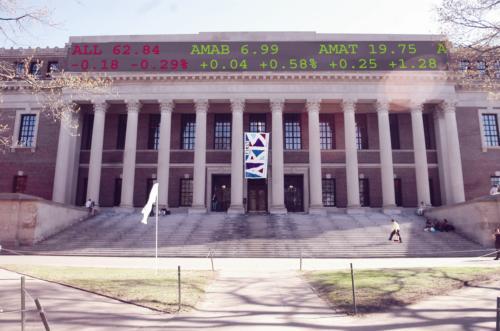
News
Summers Will Not Finish Semester of Teaching as Harvard Investigates Epstein Ties

News
Harvard College Students Report Favoring Divestment from Israel in HUA Survey

News
‘He Should Resign’: Harvard Undergrads Take Hard Line Against Summers Over Epstein Scandal

News
Harvard To Launch New Investigation Into Epstein’s Ties to Summers, Other University Affiliates

News
Harvard Students To Vote on Divestment From Israel in Inaugural HUA Election Survey
Trading Stocks—And Late for Class

Imagine that you’ve found the perfect buy. It’s down more than it should be, and you’re perfectly poised to strike and make a couple of percentage points when the market adjusts.
Suddenly, your computer clock jolts you back to reality. Rather than cashing in, you have to rush to class.
Such is the life of a Harvard trader.
Although many Harvard undergraduates covet jobs on Wall Street, a few intrepid students start trading early, seeking to make a profit from the market’s twists and turns during their college years.
GOAL: ‘50 PERCENT A YEAR’
Active traders can draw from a range of techniques, flipping stocks based on company valuations, market-moving news, or even gut intuition.
Julius D. Krein ’08 has found the strategy he likes and sticks to it.
“I look for stocks that have gone down significantly—around 10 percent—without justifiable reasons,” he says, “and I buy.
“My goal is to take advantage of irrational exuberance in the short run,” he adds.
Krein offers the example of a company’s earnings falling short of expectations, after which the market will often “overreact.”
Rather than overreaching to try to find a good buy, Krein sits back until he sees something he likes.
“I do about one or two trades a day,” he said. “If I don’t find anything, I don’t trade.”
He eschews many of the more creative ways to increase his buying power, such as trading on borrowed funds.
“A lot of people do a lot of leveraging or hedging, but I don’t,” Krein says.
Krein’s techniques are paying off despite their simplicity.
“My goal is 1 percent a week, which is 50 percent a year,” he says. “I made over 30 percent in 2006, which was an especially forgiving market.”
The S&P 500 index grew 15.8 percent in 2006.
This year, he is up 6 percent so far.
Krein started trading to prepare for a career in investment banking, and sees it as a “good way to learn about companies and industries.” He keeps at it today because, he says, “it’s fun.”
PROFITABLE, SECRETIVE
The most visible student investors shy away from the hectic lifestyle of active trading, satiating their appetite for investing by participating in on-campus groups.
The Charles River Growth Fund was established in 1994, and its 30-member board meets weekly to make investment decisions.
The Harvard Investment Association is also starting up a fund, as is the newly launched Smart Woman Securities, which was formed by a few members of the Women in Business group with $10,000 in seed money.
Rather than trying to turn quick profits, the groups are more interested in taking their members through the ins and outs of investing.
But other traders on campus use more aggressive tactics.
For some, those techniques are couched in secrecy. Four Harvard traders contacted by The Crimson declined to speak on the record about their investments.
One Cabot House junior agreed to speak if his identity would not be revealed. The Crimson granted anonymity to the junior in order to protect his privacy.
At his peak, the junior said he executed 8 to 10 trades, totaling six figures, each day. He still trades actively.
Driving those trades is simple technical analysis and charting, a sometimes-maligned branch of investing that involves trading based on patterns found in stock charts and market data.
“If a stock jumps up 10 percent in the morning because Merrill Lynch upgraded it from ‘hold’ to ‘buy,’ and I see the chart form a peak, I’ll [sell it short], because I know it’s encountering resistance,” the junior says. “If you follow the stock market closely enough, you’ll start to see patterns.”
The most active investors, day traders, try to hold onto a particular stock only as long as is necessary to turn a profit.
The Cabot House junior would not reveal his earnings.
“I’m not exactly breaking the bank, but I won’t have trouble paying my school fees,” he says.
AN EFFICIENT MARKET?
As any economics student will tell you, many of the methods employed by these traders aren’t supposed to work.
Among economists, a popular view is the “Efficient Market Hypothesis” (EMH), which argues that all stocks are correctly valued by the market. By the time any small investor gets a hold of market-moving information, the opportunity to profit will have passed, the theory says.
As early as 1973, economic theorist Burton G. Malkiel ’53 attacked so-called “chartists” who try to profit from technical analysis.
So who is right: a Princeton economist or a handful of Harvard undergraduates?
Krein agrees that the EMH holds true in the long run, but says the market is inefficient over a short time span.
The junior in Cabot House agrees but expresses some doubt over his own strategies.
“I’m not necessarily a believer in technical analysis. But I am because everyone else is,” he says.
—Staff writer Maxwell L. Child can be reached at mchild@fas.harvard.edu.
Want to keep up with breaking news? Subscribe to our email newsletter.
